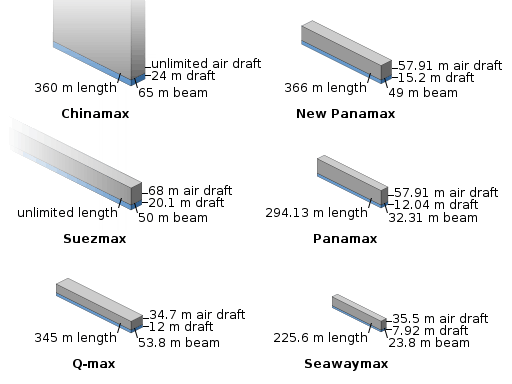Seawaymax
| General characteristics | |
|---|---|
| Tonnage: | 28,500 DWT |
| Length: | 740 ft (225.6 m) |
| Beam: | 78 ft (23.8 m) |
| Height: | 116.5 ft (35.5 m) |
| Draft: | 26.51 ft (8.1 m) |


The term Seawaymax refers to vessels which are the maximum size that can fit through the canal locks of the St. Lawrence Seaway, linking the inland Great Lakes of North America with the Atlantic Ocean.[1]
Seawaymax vessels are 740 feet (225.6 m) in length, 78 feet (23.8 m) wide, and have a draft of 26.51 feet (8.08 m) and a height above the waterline of 35.5 metres (116 ft). A number of lake freighters larger than this size cruise the Great Lakes and cannot pass through to the Atlantic Ocean. The size of the locks limits the size of the ships which can pass and so limits the size of the cargoes they can carry. The record tonnage for one vessel on the Seaway is 28,502 tons of iron ore while the record through the larger locks of the Great Lakes Waterway is 72,351 tons. Most new lake vessels, however, are constructed to the Seawaymax limit to enhance versatility by allowing the possibility of off-Lakes use. SS Edmund Fitzgerald, famous for her wreck in 1975, was the first ship constructed close to Seawaymax size.
References
- ↑ Taylor, D; et al. (2007). "Investigations into Ship Induced Hydrodynamics and Scour in Confined Shipping Channels" (PDF). Journal of Coastal Research (SI50): 499–504.